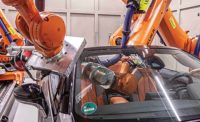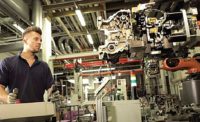Building a car generates massive amounts of data throughout the value chain. The BMW Group uses its Smart Data Analytics digitalization cluster to analyze this data selectively and enhance its production system. Results from intelligent data analysis make an effective contribution towards improving quality in all areas of production and logistics.
Data-driven improvements to processes and systems help reduce lead times and lower costs. New solutions are being developed not only at headquarters, but at many different points in the international production network. In this way, the BMW Group is able to take advantage of a wide range of innovations that open up additional options for even more flexible production.
The company uses an access-protected intranet-of-things platform to link the large quantity of sensor and process data from production and logistics quickly and easily. Smart Data Analytics offers new opportunities that extend beyond previous analysis possibilities. The speed with which new solutions can be implemented is significant. At the same time, new IoT sensors, combined with cloud and big data technologies, are reducing the technical complexity and implementation costs.
“Smart Data Analytics is setting new standards for our production system,” says Christian Patron, head of innovation and digitalization in production system. “By combining the experience of our staff with new possibilities for efficient processing of large data volumes, we are able to create accurate forecasts and proactively optimize processes. This speeds up continuous improvement of our production system in line with the basic principles of lean production.”
Laser-Marking Body Parts
Steel coils up to 40 tons and about three kilometers long are cut into blanks in the press shop and then formed into body parts. However, sheet thickness, strength, surface texture and degree of oiling are not uniform throughout the coil. Deviations from target can lead to cracks in body parts that are subjected to particular stress during the forming process.
This is where the Smart Data Analytics application at BMW’s plant in Regensburg, Germany, comes in. A laser is used to mark each blank with a multi-digit code, serving as an ID. Going forward, this will allow the presses to be fine-tuned to accommodate the characteristics of the blank. If needed, the ID may contain a control command which can, for example, trigger additional oiling of the blank in the press before forming.
Each body part is assigned information that remains available throughout all subsequent production steps. Since the blank stays in its production line for marking, the ID is assigned without any cycle downtime. The ID is designed so that it remains visible throughout car body construction.
BMW Group planning specialists already take advantage of the traceability of all parts for further optimization involving additional algorithms. For example, taking into account the characteristics measured for each individual body part, the gap dimensions of the finished body can be further optimized, or the paint application better matched to the surface of that particular body.
Fine-tuning of press parameters according to the properties of the blank is already having a major impact—the number of scrapped parts is significantly lower, with better utilization of the coil material and reduced system downtime required for fault analysis.
Predictive Maintenance for Body Shop
Smart Data Analytics applications offer especially high potential for increasing the availability of production equipment and machines in highly automated areas of manufacturing. Maximum accuracy in predicting risk of breakdown helps avoid unplanned system downtime. Based on the forecast, maintenance staff can plan a targeted maintenance intervention to limit downtimes to a minimum.
This “predictive maintenance” is enabled by intelligent analysis of large quantities of real production, sensor and process data—targeted analysis of this information makes it possible to determine when to replace wearing parts used in production. If the change is made too late, there is a risk of production stoppage; made too early, valuable resources are wasted.
Without the relevant data, the purely preventive maintenance of the past was conducted without knowing the actual state of wear. This method required allowing safety margins for the timing of the changeover, but could not detect unexpected breakdowns.
Data-based solutions for predictive maintenance are used at various stages in car body production to predict wear in robots. Sensors in welding tongs signal ahead of time when defects or quality problems are likely to occur. Wide-scale sensor monitoring also improves the reliability of the electrical drives used in a variety of systems, including lifts and turntables. Robots and control technology are fitted with the sensors, allowing maintenance staff analyze the data and draw the right conclusions.
Online Process Controls
The BMW Group received the Prix de la Technique 2017 at the prestigious Surcar Congress in Cannes, France, for its concept for comprehensive paint shop digitalization at the company’s new plant in San Luis Potosí, Mexico, which will begin series production in 2019. BMW Group paint shops already use sensors for ongoing monitoring of automated production processes.
Intelligently networked systems enhance the stability of process sequences, enable predictive maintenance and ensure the highest quality for customers. Online process control combines the strengths of algorithm-based analysis of large data volumes with employee experience. As a result, humans can focus more on their role as architects of the production process, since real production data is sorted and optimally prestructured for them. Error potential can be detected in time and rework avoided.
In May 2017, the BMW Group began using fully automated quality control for the first time at its Munich plant, with robots scanning the entire outer vehicle surface. The system is capable of detecting errors the human eye cannot perceive. This data obtained also provides valuable feedback on the precision of upstream painting processes—allowing continuous optimization and timely identification of defect potential.
Fastener Data and Error Prevention
Bolted connections are fundamental to automobile production, since every vehicle contains hundreds of them. The BMW Group monitors and analyzes all bolted connections that are relevant to safety. The bolted connections that do not, or only partly, meet the desired specifications may require rework. With its preventive quality strategy, the BMW Group has developed algorithms that have been analyzing bolted connections in more than 3,200 assembly systems at all vehicle plants since July 2017.
Recording and analysis of bolting process curves provide accurate feedback on the quality of bolted connections. The program can recognize different types of fault and show possible sources of error in a cause-and-effect diagram. The BMW Group uses this information to train and qualify employees for preventive quality work—a mistake that is not made does not need correcting. A trainer can then also provide tips on error avoidance.
Analysis of bolting process curves also provides important insights for systematic monitoring of bolting systems and parameters, such as tightening torque. When implemented quickly, these findings create a closed loop of continuous improvement.
In many cases, manual analysis of bolting process curves would only result in a finding of “acceptable” or “not acceptable,” without identifying the cause of errors or highlighting potential for improvement.
Maintenance and Materials Handling
The BMW Group production system is characterized by the highest degree of flexibility. The company produces a wide range of models and variants on its assembly lines, but is nevertheless competitive—as confirmed by independent benchmarks. On the assembly line, a reliable supply of materials is particularly important. A breakdown at any point could cause the entire production area to grind to a halt.
In assembly, many conveyor systems are now equipped with a large number of sensors that monitor various factors, especially temperature, vibration and electrical power. These sensors are cost-effective enough to allow them to be widely used. Data from these sensor kits and other process data is streamed live to the BMW internet-of-things platform, where it is visualized and analyzed in real-time.
If the data detects a trend indicating deviation or patterns from previous breakdowns, the platform notifies maintenance staff. Staff can then decide whether the hanger should be removed for maintenance. In this way, it is possible to ensure long-term, reliable operation of the conveyor system over a number of years.
“In automotive production, every second counts. If a part isn’t available on time or a system fails, the production process is delayed and it disrupts the value chain,” notes Patron. “Intelligent use of production data ensures a stable and efficient process. We see tremendous potential in Smart Data Analytics for incorporating feedback from our customers into development and production even faster.”







